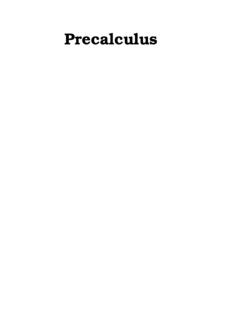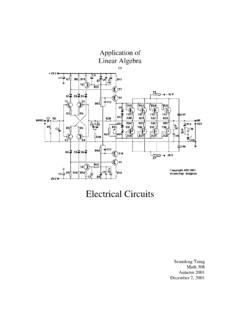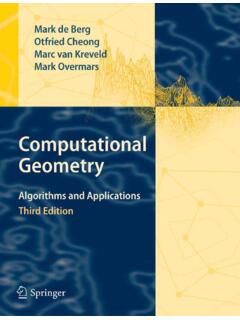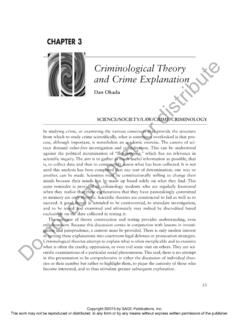Transcription of Math 407 — Linear Optimization 1 Introduction
1 Math 407 Linear Optimization1 What is Optimization ?A mathematical Optimization problem is one in which some function is either maximized orminimized relative to a given set of alternatives. The function to be minimized or maximizedis called theobjective functionand the set of alternatives is called the feasible region (orconstraint region). In this course , the feasible region is always taken to be a subset ofRn(realn-dimensional space) and the objective function is a function further restrict the class of Optimization problems that we consider to Linear program-ming problems (or LPs). An LP is an Optimization problem overRnwherein the objectivefunction is a Linear function, that is, the objective has the formc1x1+c2x2+ +cnxnfor someci2Ri=1,..,n,andthefeasibleregionist hesetofsolutionstoafinitenumberof Linear inequality and equality constraints, of the formai1xi+ai2x2+ +ainxn bii=1,..,sandai1xi+ai2x2+ +ainxn=bii=s+1.
2 , programming is an extremely powerful tool for addressing a wide range of appliedoptimization problems. A short list of application areas is resource allocation, produc-tion scheduling, warehousing, layout, transportation scheduling, facility location, flight crewscheduling, portfolio Optimization , parameter estimation, .. An ExampleTo illustrate some of the basic features of LP, we begin with a simple two-dimensionalexample. In modeling this example, we will review the four basic steps in the developmentof an LP model:1. Identify and label thedecision Determine the objective and use the decision variables to write an expression for theobjective functionas a Linear function of the decision Determine theexplicit constraintsand write a functional expression for each of themas either a Linear equation or a Linear inequality in the decision Determine theimplicit constraints,andwriteeachaseitheralineare quationoralinearinequality in the decision CUP FACTORYA local family-owned plastic cup manufacturer wants to optimize their productionmix in order to maximize their profit.
3 They produce personalized beer mugs andchampagne glasses. The profit on a case of beer mugs is $25 while the profit onacaseofchampagneglassesis$ a plastic extruder which feeds on plastic resins. Each case of beer mugsrequires 20 lbs. of plastic resins to produce while champagne glasses require 12lbs. per case. The daily supply of plastic resins is limited to at most 1800 15 cases of either product can be produced per hour. At the moment thefamily wants to limit their work day to 8 will model the problem of maximizing the profit for this company as an LP. The firststep in our modeling process is to identify and label thedecision that represent the quantifiable decisions that must be made in order to determinethe daily production schedule. That is, we need to specify those quantities whose valuescompletely determine a production schedule and its associated profit. In order to determinethese quantities, one can ask the question If I were the plant manager for this factory,what must I know in order to implement a production schedule?
4 The best way to identifythe decision variables is to put oneself in the shoes of the decision maker and then ask thequestion What do I need to know in order to make this thing work? In the case of theplastic cup factory, everything is determined once it is known how many cases of beer mugsand champagne glasses are to be produced each Variables:B=# # will soon discover that the most di cult part of any modeling problem is identifyingthe decision variables. Once these variables are correctly identifies then the remainder of themodeling process usually goes identifying and labeling the decision variables, one then specifies the problem ob-jective. That is, write an expression for the objective function as a Linear function of thedecision Function:Maximize profit where profit = 25B+20 CThe next step in the modeling process is to express the feasible region as the solution setof a finite collection of Linear inequality and equality constraints.
5 We separate this processinto two steps:31. determine the explicit constraints, and2. determine the implicit explicit constraints are those that are explicitly given in the problem statement. In theproblem under consideration, there are explicit constraints on the amount of resin and thenumber of work hours that are available on a daily Constraints:resin constraint: 20B+12C 1800work hours constraint:115B+115C problem also has other constraints called implicit constraints. These are constraintsthat are not explicitly given in the problem statement but are present nonetheless. Typicallythese constraints are associated with natural or common sense restrictions on the deci-sion variable. In the cup factory problem it is clear that one cannot have negative cases ofbeer mugs and champagne glasses. That is, bothBandCmust be non-negative Constraints:0 B,0 entire model for the cup factory problem can now be succinctly stated asP:max25B+20 Csubject to 20B+12C 1800115B+115C 80 B, CSince it is an introductory example, the Plastic Cup Factory problem is particularlyeasy to model.
6 As the course progresses you will be asked to model problems of increasingdi culty and complexity . In this regard, let me emphasize again that the first step in themodeling process, identification of the decision variables, is always the most di cult. Inaddition, the 4 step modeling process outlined above is not intended to be a process thatone steps through in a Linear fashion. As the model unfolds it is often necessary to revisitearlier steps, for example by adding in more decision variables (a very common requirement).Moving between these steps several times is often required before the model is complete. Inthis process, the greatest stumbling block experienced by students is the overwhelming desireto try to solve the problem as it is being modeled. Indeed, every student who has takenthis course over has made this error (and on occasion I continue to make this error myself).Perhaps the most common error in this regard is to try to reduce the total number of decisionvariables required.
7 This often complicates the modeling process, blocks the ability to fullycharacterize all of the variability present, makes it di cult to interpret the solution and4understand its robustness, and makes it di cult to modify the model as it afraid to add more decision variableseither to clarify the model or to improve itsflexibility. Modern LP software easily solves problems with tens of thousands of variables,and in some cases tens of millions of variables. It is more important to get a correct, easilyinterpretable, and flexible model then to provide a compact minimalist now turn to solving the Plastic Cup Factory problem. Since this problem is twodimensional it is possible to provide a graphical representation and solution. The first stepis to graph the feasible region. To do this, first graph14151312141110985674321235 6 7 8 9 10 11 12 13 14 15feasible regionBoptimal value = $262520B+12C=1800solution BC = 4575 115B+115C=8 Cobjective normaln= 2520 15the line associated with each of the Linear inequality constraints.
8 Then determine on whichside of each of these lines the feasible region must lie (don t forget the implicit constraints!).To determine the correct side, locate a point not on the line that determines the constraint(for example, the origin is often not on the line, and it is particularly easy to use). Plugthis point in and see if it satisfies the constraint. If it does, then it is on the correct side ofthe line. If it does not, then the other side of the line is correct. Once the correct side isdetermined put little arrows on the line to remind yourself of the correct side. Then shade inthe resulting feasible region which is the set of points feasible for all of the Linear next step is to draw in the vector representing the gradient of the objective vector may be placed anywhere on your graph, but it is often convenient to draw itemanating from the origin. Since the objective function has the formf(x1,x2)=c1x1+c2x2,the gradient offis the same at every point inR2;rf(x1,x2)= c1c2.
9 Recall from calculus that the gradient always points in the direction of increasing functionvalues. Moreover, since the gradient is constant on the whole space, the level sets offassociated with di erent function values are given by the lines perpendicular to the , to obtain the location of the point at which the objective is maximized wesimply set a ruler perpendicular to the gradient and then move the ruler in the direction ofthe gradient until we reach the last point (or points) at which the line determined by theruler intersects the feasible region. In the case of the cup factory problem this gives thesolution to the LP as BC = 4575 We now recap the steps followed in the solution procedure given above:Step 1:Graph each of the Linear constraints indicating on which side of the constraint thefeasible region must lie with an arrow. Don t forget the implicit constraints!Step 2:Shade in the feasible 3:Draw the gradient vector of the objective 4:Place a straight-edge perpendicular to the gradient vector and move the straight-edge either in the direction of the gradient vector for maximization (or in the oppo-site direction of the gradient vector for minimization) to the last point for which thestraight-edge intersects the feasible region.
10 The set of points of intersection betweenthe straight-edge and the feasible region is the set of solutions to the 5:Compute the exact optimal vertex solutions to the LP as the points of intersectionof the lines on the boundary of the feasible region indicated in Step 4. Then computethe resulting optimal value associated with these solution procedure described above for two dimensional problems reveals a great dealabout the geometric structure of LPs that remains true inndimensions. We will explore thisgeometric structure more fully as the course evolves. For the moment, note that the solutionto the Plastic Cup Factory problem lies at acorner pointof the feasible region. Indeed, it iseasy to convince oneself that every 2 dimensional LP has an optimal solution that is such acorner space whereit is referred to as leaving this section, we make a final comment on the modeling process describedabove. We emphasize that there is not one and only one way to model the Cup Factoryproblem, or any problem for that matter.


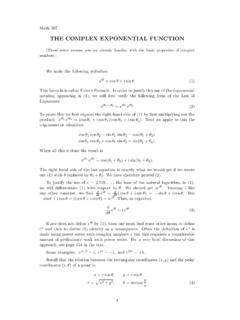

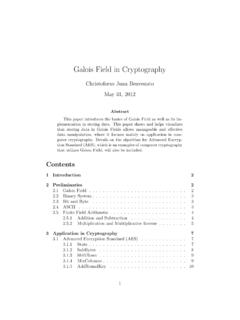

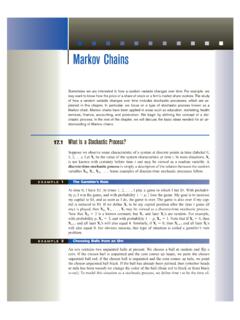
![ZZ dA R [0 2] R - University of Washington](/cache/preview/6/4/c/c/9/f/d/6/thumb-64cc9fd6ac93e2995c04a2a74b217176.jpg)
